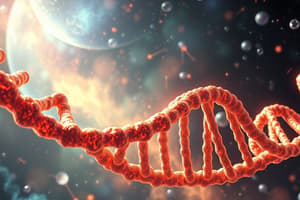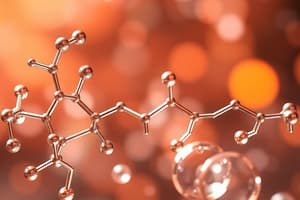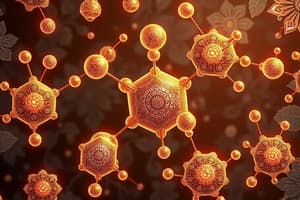Podcast
Questions and Answers
Which of the following elements is NOT considered a key element in living organisms?
Which of the following elements is NOT considered a key element in living organisms?
- Carbon
- Sodium (correct)
- Nitrogen
- Phosphorus
Which of the following is NOT a characteristic of carbohydrates?
Which of the following is NOT a characteristic of carbohydrates?
- They are composed of carbon, hydrogen, and oxygen.
- They include fats, oils, and steroids. (correct)
- They can be classified into monosaccharides, disaccharides, and polysaccharides.
- They are the primary source of energy for living organisms.
Which type of lipid forms the cell membrane?
Which type of lipid forms the cell membrane?
- Steroids
- Oils
- Fats
- Phospholipids (correct)
What is the specific type of bond that links amino acids together to form proteins?
What is the specific type of bond that links amino acids together to form proteins?
Which of the following is a function of proteins?
Which of the following is a function of proteins?
Which of the following is NOT true about water?
Which of the following is NOT true about water?
What property of water is responsible for its ability to stick to other surfaces, such as plant cell walls?
What property of water is responsible for its ability to stick to other surfaces, such as plant cell walls?
Which of the following best describes the difference between saturated and unsaturated fats?
Which of the following best describes the difference between saturated and unsaturated fats?
Flashcards
Chemistry of Life
Chemistry of Life
The study of chemical processes in living organisms essential for growth and survival.
Key Elements in Life
Key Elements in Life
Elements like carbon, hydrogen, oxygen, nitrogen, phosphorus, and sulfur (CHONPS) that are fundamental in organisms.
Organic Molecules
Organic Molecules
Molecules that contain carbon and are fundamental to life processes.
Carbohydrates
Carbohydrates
Signup and view all the flashcards
Lipids
Lipids
Signup and view all the flashcards
Proteins
Proteins
Signup and view all the flashcards
Nucleic Acids
Nucleic Acids
Signup and view all the flashcards
Properties of Water
Properties of Water
Signup and view all the flashcards
Study Notes
Introduction to the Chemistry of Life
- The study of the chemical processes within living organisms is the chemistry of life.
- These processes are crucial for all aspects of life, from growth to survival.
- Key elements for life include carbon, hydrogen, oxygen, nitrogen, phosphorus, and sulfur (CHONPS).
- These elements are the building blocks of all biomolecules.
Organic Molecules
-
Organic molecules all contain carbon.
-
Carbon's ability to make four covalent bonds allows a wide variety of complex structures.
-
Carbohydrates:
- Composed of carbon, hydrogen, and oxygen.
- Provide energy for living organisms.
- Include monosaccharides, disaccharides, and polysaccharides.
- Starch is a plant glucose storage molecule.
- Glycogen is an animal glucose storage molecule.
-
Lipids:
- Diverse, nonpolar molecules, including fats, oils, and steroids.
- Crucial for energy storage, insulation, and protection.
- Fats are solid at room temperature; oils are liquid.
- Composed of fatty acids and glycerol.
- Saturated fats lack double bonds, unsaturated fats have at least one double bond.
- Phospholipids make up cell membranes.
- Cholesterol and other steroids have a four-ring structure, and play a role in hormone production.
-
Proteins:
- Made of amino acids.
- Essential for structure, function, and regulation.
- Include enzymes, transport proteins, and defense proteins.
- Enzymes speed up chemical reactions.
- Amino acids join via peptide bonds to form polypeptide chains.
- The amino acid order determines a protein's shape and function.
-
Nucleic Acids:
- Made of nucleotides.
- Carry genetic instructions.
- Include DNA and RNA.
- DNA stores genetic information; RNA plays roles in protein synthesis.
- Nucleotides have a sugar, a phosphate group, and a nitrogenous base.
Water
- Water is crucial for all life.
- Its unique properties (polarity, cohesion, adhesion, and high specific heat) are vital for biological processes.
- Water's polarity allows it to dissolve many substances (hydrophilic).
- Cohesion creates surface tension.
- Adhesion allows water to cling to other substances.
- Water's high specific heat helps regulate temperatures.
Acids, Bases, and pH
- Acids release hydrogen ions (H+) in water.
- Bases release hydroxide ions (OH-) in water.
- pH measures the concentration of H+ ions.
- The pH scale ranges from 0 to 14.
- pH 7 is neutral.
- pH below 7 is acidic.
- pH above 7 is basic.
- Buffers prevent drastic pH changes.
Chemical Reactions
- Chemical reactions involve breaking and forming bonds.
- Metabolism encompasses all chemical reactions in an organism.
- Catabolism breaks molecules down; anabolism builds molecules up.
Studying That Suits You
Use AI to generate personalized quizzes and flashcards to suit your learning preferences.




